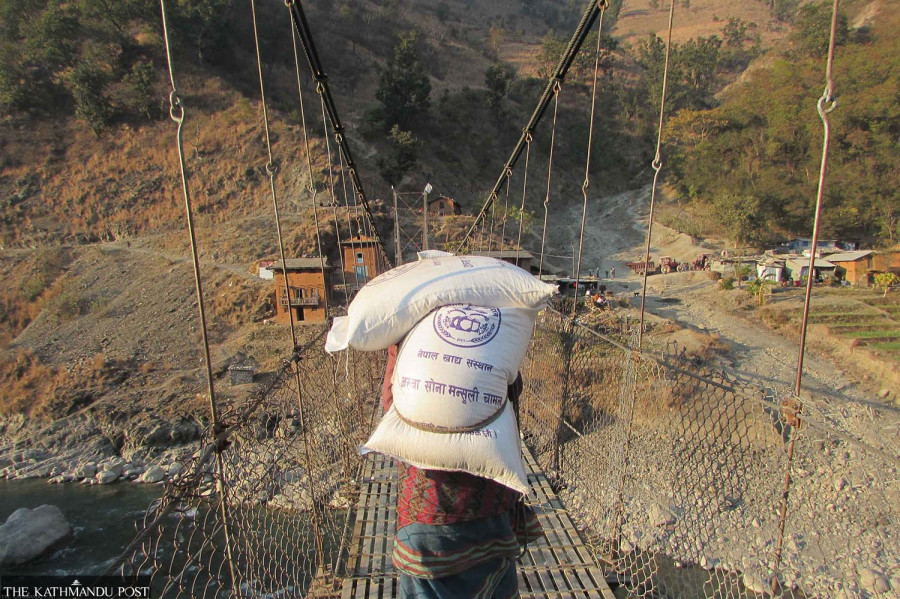Money
Fortified rice to be produced to fight malnutrition
The Department of Food Technology has proposed raising the recommended micronutrient content for fortified rice.
Krishana Prasain
The Department of Food Technology and Quality Control has proposed raising the recommended micronutrient content for fortified rice to fight malnutrition in the country, particularly in rural communities.
Fortifying rice means adding micronutrients like iron, folic acid and Vitamin B12. It is a cost-effective and complementary strategy to increase vitamin and mineral content in the diet.
Rice is one of Nepal’s staple foods, consumed by almost the entire population.
“Adding nutrients to rice will help improve nutritional content,” said Matina Joshi Vaidya, director general at the Department of Food Technology and Quality Control.
A memorandum of understanding was signed in mid-June 2019 between the Ministry of Industry, Commerce and Supplies, Ministry of Health, Department of Food Technology and Quality Control and Food Management and Trading Company to enhance the standard of fortified rice for specific objectives, especially targeting malnourished women and children.
A recent report on hunger has painted a bleak picture of Nepal's hunger level. The country ranks 81st out of 121 countries in the 2022 Global Hunger Index, with a score of 19.1, which indicates that the country is at the borderline between moderate and serious levels of hunger.
“There has been a small improvement from the past, but there is no reason to cheer, as we are still at high risk of serious hunger problems,” Dr Atul Upadhyay told the Post. “Many people in the country have not been getting adequate nutritious food,” the nutrition expert said.
The report showed that 12 percent of children under five suffer from wasting, which is the major indicator for mapping Global Hunger Index scores.
Only 10 percent of the children in this age group were suffering from wasting, according to the Nepal Demographic Health Survey 2016.
Wasting or low weight for a particular height is an undernutrition condition, which is a strong predictor of mortality among children under five, according to the UN health agency. Wasting in children is associated with a higher risk of death if not treated properly, it said.
Vaidya said that the National Health Survey 2016 showed that lack of micronutrients like iron, zinc, folic acid and vitamin causes deficiency diseases like anaemia.
“Pregnant women and newborn children still face nutrition deficiency causing different health problems. We prepared the standard for fortified rice on the basis of the National Health Survey 2016,” Vaidya said.
"Some fortified rice is being distributed in Karnali and Sudurpaschim under the World Food Programme. Till now, there is no provision for fortifying rice in Nepal, that is why these standards have been created to produce such rice in the country," she said.
“Food Management and Trading Company will produce fortified rice in Rajapur and Janakpur in the initial phase with government subsidies. If the private sector also wants to produce fortified rice commercially, it can do so by following the standards.”
The department will check that fortified rice is being produced as per the stipulations. The government will cover the extra cost of making fortified rice in the beginning. The price of fortified rice will be Rs1-2 higher per kg than normal rice.
A fortified rice kernel is mixed with normal rice and it does not change after cooking and tastes similar to normal rice.
"After the standards are approved by the World Trade Organisation, they will be published in the Nepal Gazette and brought into implementation," Vaidya said.
Rice mixed with 0.5 to 2.0 percent fortified rice kernels is called fortified rice, according to the proposed standards.
Fortified rice should have an iron content of 39 to 72 milligrams per kilogram, zinc 32 to 59 milligrams per kilogram, Vitamin A 0.89 to 2.21 milligrams per kilogram, folic acid 0.24 to 0.59 milligram per kilogram and Vitamin B12 0.007 to 0.020 milligram per kilogram, as per the recommended standards.
In addition to the above nutrients, thiamin (Vitamin B1) can be added in the range of 2.3 to 5.6 milligrams per kilogram; niacine (Vitamin B3) 20.5 to 50.7 milligrams per kilogram; and pyridoxine (Vitamin B6) 1.9 to 4.8 milligrams per kilogram.
The use of compounds like thiamin mononitrate as a source of thiamin, nicotinamide as a source of niacin and pyridoxine hydrochloride as a source of pyridoxine can be made when improving the nutritional quality of rice.
The level of contaminants, toxins and residues should not exceed the maximum levels set by the government.
The production, packaging, handling, storage and transportation of fortified rice should be according to the approved purity work procedure of the Ministry of Agriculture and Livestock Development.
The nutrition-enhanced fortified rice needs to be sealed in clear and dry food packaging material. The fortified rice package should be clearly labelled as "+F” and "nutrition substance enhanced rice". The label on the package also needs to show details like the name, quantity and nutrition source.
The proposed standards will be implemented on fortified rice produced and packaged for human consumption.
The rice that will be fortified should be clear grain produced from the Oryza sativa Linn type of paddy. The rice needs to be dry and clear with the same colour free of fungus, insects, artificial colour or harmful substances. The moisture content of the rice should not be higher than 15 percent on the basis of weight.
The amount of outside substances like filth in the rice should not be more than 0.1 percent on the basis of weight, organic extraneous matter not more than 0.5 percent on the basis of weight, and inorganic extraneous matter not more than 0.1 percent on the basis of weight.
The amount of total outside substances should not be more than 0.7 percent of the total weight.
The amount of heat-damaged grains should not exceed 3 percent on the basis of weight, damaged grains not more than 3 percent, immature kernels not more than 2 percent, and chalky kernels not more than 7 percent.
The amount of red kernels should not be more than 4 percent on the basis of weight, and red streaked kernels not more than 8 percent.
The amount of broken rice should not be more than 25 percent, chips not more than 0.1 percent, and paddy not more than 0.3 percent on the basis of weight.
The amount of contaminants in the rice such as mycotoxin and uric acid should not exceed 20 mg per kg and 100 mg per kg respectively.




 16.57°C Kathmandu
16.57°C Kathmandu















